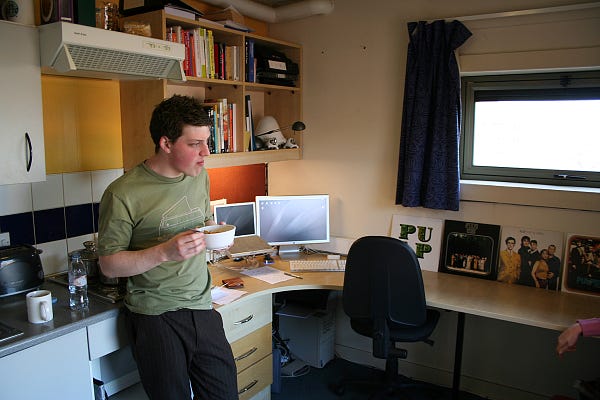The Difference Between “Remote” and “Remote-First” — ReadThink (by HubSpot)
Thoughts on building a remote culture, from a remote CEO

One of my goals as the CEO of Litmus is to build the company I want to work for. It’s the reason we offer 28 days of paid vacation, the best equipment, Spotify accounts, retirement plans, stock options, and so on.
It’s also the reason we give our employees the freedom to work anywhere.
The decision to go remote-first — i.e. work wherever you feel empowered to do your best work — was an important inflection point for the company. We’d spent years hiring local talent in Boston and London, all the while making exceptions for great people in other cities and countries.
Inequalities developed. Our remote workers felt comfortable taking a break to run a quick errand or go for a run. Our local employees adhered to a more traditional work schedule. I much prefer clarity — and I also prefer a flexible schedule — so in 2014 we decided to extend the option to work remotely to all of our employees.
One misconception about remote work is that it hinders collaboration. In my experience, the inverse is more likely: offices hinder independent work.
At Litmus, remote work isn’t about traveling the world (although we’re happy for our employees to work anywhere) or working without trousers (that’s fine too), it’s about creating an environment that empowers people do their best work and enjoy their lives.
Remote-first is different than remote. Here’s a little more on our philosophy.
Remote is a mindset, not a place
We started Litmus with a few old computers and a dorm room internet connection. There was no need (or money) for an actual office, so we worked from wherever we could. We’d get together now and then, but the bulk of our work was done in solitude.

These were formative years. We learned how to communicate and how to work independently. We learned to hire the best people, wherever they were. When we finally opened a real office, those principles were already established. We ended up working “remotely” from our individual offices in the Boston HQ instead of our homes or a coffee shop.
One misconception about remote work is that it hinders collaboration. In my experience, the inverse is more likely: offices hinder independent work. Collaboration tends to happen in short bursts, followed by longer periods of writing, designing, coding and thinking. It’s more important to give employees quiet time than it is to cram them into an open office.
The office still matters
Litmus is a remote company with a collective 15,000 square feet of office space. That might sound crazy, but I believe offices afford some benefits that distributed work simply can’t replace.
We’ve had a remote-first mindset since the beginning, but we’ve also always had some kind of office space for meetings, collaboration and socializing. First it was a little corner of coworking space, then a small office and eventually a full-fledged HQ.
Just because an office exists doesn’t mean people should be required to work in it.
Today, just under half of our employees live in the Boston area. They are free to come to our HQ whenever they like. We encourage (but don’t require) people to spend Thursdays in the office to catch up, have meetings and grab a drink afterwards. I don’t love the 9–5 culture that offices seem to require, but I do really enjoy spending time with our team. We’ve hired so many great people, it would be a shame to never see them.

The opposite is true, too. We’ve hired so many great people, it would be a shame to herd them into an office if they could work better somewhere else. Just because an office exists doesn’t mean people should be required to work in it.
Offices matter, but not as much as happy, productive employees.
We don’t have all the answers
There are a few challenges we haven’t quite figured out yet. It’s difficult, for example, to plan for office space. Our 7,000 square foot floor in Boston is cavernous for the ten or so people regularly working from it. On the other hand, when we have team meet-ups, space is so tight that people have to cram on couches.
Offering equal perks is also a challenge. Each morning, office-based employees get an email asking them what they’d like for lunch. At noon, their food arrives, courtesy of the company. We still haven’t figured out how to offer a similar benefit to remote employees. A $10 lunch voucher just isn’t the same — perks like this don’t translate well into cash.
When a CEO uses their lunch break to hit the gym, others feel empowered to do the same. And when a manager spends their entire vacation answering emails, it’s harder for others to disconnect in their own downtime.
It’s easy to cast these issues aside as “first world problems.” And yes, we are very lucky to be in a position to invest so much in our employees. It’s also part of our strategy to grow. The decisions we make now validate our current employees’ belief in our leadership team and will attract more great people in the future.
The 10 tenets of a remote-first company
Success begins with a philosophy. I believe in the remote-first model, but there are plenty of nuts and bolts required to make it effective. Here are a few.
- Commit. We are remote-first 100% of the time. Unless every person is in the same room, all meetings are held over videoconference. This is absolutely essential and was a game-changer for us.
- Communicate deliberately. Put processes in place for communication. Edits go in Google Docs, status updates go in Basecamp, files go in Dropbox, meetings happen on Blue Jeans. Make sure everyone knows where and how to communicate.
- Lead by example. The behavior of the leadership team influences company culture more than a core values document. When a CEO uses their lunch break to hit the gym, others feel empowered to do the same. And when a manager spends their entire vacation answering emails, it’s harder for others to disconnect in their own downtime.
- Trust your team. Hire smart people that can work autonomously to avoid creating a culture of micromanagement. Work only gets done when you allow people to make mistakes.
- Clarify expectations. “Can I take a break to walk my dog?” “Can I do laundry between meetings?” We learned early on that it’s important to let people know it’s okay to embrace the remote lifestyle. (The answer to both questions is a resounding “yes.”)
- Log out. Tools like Slack help us communicate, but it’s okay to log out. We encourage our employees to disconnect so they can tackle their work without distractions. As Jason Fried wrote, “Treat [group] chat like a sauna — stay a while but then get out.”
- Make time for socialization. A few times a year, we have company get-togethers and smaller teams meet in-person more often. Week to week, we get Coworker Coffees, drink beers on Skype, and play video games online. And we invite local employees to the office every Thursday.
- Expect pushback. Not everyone loves remote work and that’s okay. That’s why we keep an office and offer WeWork memberships to anyone who lives near a location.
- Ask for feedback. Problems do come up with remote work. We use Know Your Company to get a steady stream of feedback from our employees. Tools like this make it easy to be pro-active.
- Embrace the freedom. You probably wouldn’t do yoga in your cubicle, but you can do it in your home office. You might feel like you need to skip your daughter’s 4pm soccer game because it’s during office hours. Go cheer her on! The remote office affords so much freedom. Embrace it.
Creating a great work culture isn’t a task to be checked off, it’s a seed to be nurtured. We’re serious about making Litmus a place to do work you’re proud of without burning out. And that’s just the reason I love working here.
